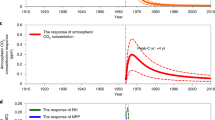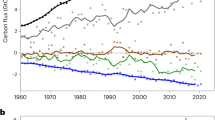Abstract
Fossil fuel combustion and land-use change are the two largest contributors to industrial-era increases in atmospheric CO2 concentration1. Projections of these are thus fundamental inputs for coupled Earth system models (ESMs) used to estimate the physical and biological consequences of future climate system forcing2,3. While historical data sets are available to inform past and current climate analyses4,5, assessments of future climate change have relied on projections of energy and land use from energy–economic models, constrained by assumptions about future policy, land-use patterns and socio-economic development trajectories6. Here we show that the climatic impacts on land ecosystems drive significant feedbacks in energy, agriculture, land use and carbon cycle projections for the twenty-first century. We find that exposure of human-appropriated land ecosystem productivity to biospheric change results in reductions of land area used for crops; increases in managed forest area and carbon stocks; decreases in global crop prices; and reduction in fossil fuel emissions for a low–mid-range forcing scenario7. The feedbacks between climate-induced biospheric change and human system forcings to the climate system—demonstrated here—are handled inconsistently, or excluded altogether, in the one-way asynchronous coupling of energy–economic models to ESMs used to date1,8,9.
This is a preview of subscription content, access via your institution
Access options
Access Nature and 54 other Nature Portfolio journals
Get Nature+, our best-value online-access subscription
$29.99 / 30 days
cancel any time
Subscribe to this journal
Receive 12 print issues and online access
$209.00 per year
only $17.42 per issue
Buy this article
- Purchase on Springer Link
- Instant access to full article PDF
Prices may be subject to local taxes which are calculated during checkout




Similar content being viewed by others
References
IPCC Climate Change 2013: The Physical Science Basis (eds Stocker, T. F. et al.) 1535 (Cambridge Univ. Press, 2013).
Hoffman, F. M. et al. Causes and implications of persistent atmospheric carbon dioxide biases in Earth System Models. J. Geophys. Res. 119, 141–162 (2014).
Shevliakova, E. et al. Carbon cycling under 300 years of land use change: importance of the secondary vegetation sink. Glob. Biogeochem. Cycles 23, 1–16 (2009).
Andres, R. J. et al. A synthesis of carbon dioxide emissions from fossil-fuel combustion. Biogeosciences 9, 1845–1871 (2012).
Hurtt, G. et al. Harmonization of land-use scenarios for the period 1500–2100: 600 years of global gridded annual land-use transitions, wood harvest, and resulting secondary lands. Climatic Change 109, 117–161 (2011).
Moss, R. H. et al. The next generation of scenarios for climate change research and assessment. Nature 463, 747–756 (2010).
Thomson, A. et al. RCP4.5: a pathway for stabilization of radiative forcing by 2100. Climatic Change 109, 77–94 (2011).
Di Vittorio, A. V. et al. From land use to land cover: restoring the afforestation signal in a coupled integrated assessment—earth system model and the implications for CMIP5 RCP simulations. Biogeosciences 11, 6435–6450 (2014).
Jones, A. D. et al. Greenhouse gas policy influences climate via direct effects of land-use change. J. Clim. 26, 3657–3670 (2013).
Ciais, P. et al. in Climate Change 2013: The Physical Science Basis (eds Stocker, T. F. et al.) (IPCC, Cambridge Univ. Press, 2013).
van Vuuren, D. et al. The representative concentration pathways: an overview. Climatic Change 109, 5–31 (2011).
Meinshausen, M. et al. The RCP greenhouse gas concentrations and their extensions from 1765 to 2300. Climatic Change 109, 213–241 (2011).
Lamarque, J.-F. et al. Global and regional evolution of short-lived radiatively-active gases and aerosols in the Representative Concentration Pathways. Climatic Change 109, 191–212 (2011).
Nelson, G. C. et al. Climate change effects on agriculture: economic responses to biophysical shocks. Proc. Natl Acad. Sci. USA 111, 3274–3279 (2014).
Humpenöder, F. et al. Land-use and carbon cycle responses to moderate climate change: implications for land-based mitigation? Environ. Sci. Technol. 49, 6731–6739 (2015).
Ruane, A. C. et al. Climate change impact uncertainties for maize in Panama: farm information, climate projections, and yield sensitivities. Agr. Forest Meteorol. 170, 132–145 (2013).
Welch, J. R. et al. Rice yields in tropical/subtropical Asia exhibit large but opposing sensitivities to minimum and maximum temperatures. Proc. Natl Acad. Sci. USA 107, 14562–14567 (2010).
Long, S. P., Ainsworth, E. A., Leakey, A. D. B., Nösberger, J. & Ort, D. R. Food for thought: lower-than-expected crop yield stimulation with rising CO2 concentrations. Science 312, 1918–1921 (2006).
Norby, R. J. et al. Forest response to elevated CO2 is conserved across a broad range of productivity. Proc. Natl Acad. Sci. USA 102, 18052–18056 (2005).
Sutton, M. A. et al. Uncertainties in the relationship between atmospheric nitrogen deposition and forest carbon sequestration. Glob. Change Biol. 14, 2057–2063 (2008).
Norby, R. J., Warren, J. M., Iversen, C. M., Medlyn, B. E. & McMurtrie, R. E. CO2 enhancement of forest productivity constrained by limited nitrogen availability. Proc. Natl Acad. Sci. USA 107, 19368–19373 (2010).
Rosenzweig, C. et al. Assessing agricultural risks of climate change in the 21st century in a global gridded crop model intercomparison. Proc. Natl Acad. Sci. USA 111, 3268–3273 (2014).
Stehfest, E. et al. Integrated Assessment of Global Environmental Change with IMAGE 3.0. Model Description and Policy Applications 370 (The Hague: PBL Netherlands Environmental Assessment Agency, 2014).
Voldoire, A., Eickhout, B., Schaeffer, M., Royer, J.-F. & Chauvin, F. Climate simulation of the twenty-first century with interactive land-use changes. Clim. Dynam. 29, 177–193 (2007).
Wise, M., Calvin, K., Kyle, P., Luckow, P. & Edmonds, J. Economic and physical modeling of land use in GCAM 3.0 and an application to agricultural productivity, land, and terrestrial carbon. Clim. Change Econ. 5, 1450003 (2014).
Hurrell, J. W. et al. The Community Earth System Model: a framework for collaborative research. Bull. Am. Meteorol. Soc. 94, 1339–1360 (2013).
Collins, W. D. et al. The integrated Earth system model version 1: formulation and functionality. Geosci. Model Dev. 8, 2203–2219 (2015).
Bond-Lamberty, B. et al. On linking an Earth system model to the equilibrium carbon representation of an economically optimizing land use model. Geosci. Model Dev. 7, 2545–2555 (2014).
Stainforth, D. A., Allen, M. R., Tredger, E. R. & Smith, L. A. Confidence, uncertainty and decision-support relevance in climate predictions. Phil. Trans. R. Soc. A 365, 2145–2161 (2007).
Strachan, N., Pye, S. & Kannan, R. The iterative contribution and relevance of modelling to UK energy policy. Energ. Policy 37, 850–860 (2009).
Food and Agriculture Organization of the United Nations (FAOSTAT, 2014); faostat3.fao.org
Kyle, P. et al. GCAM 3.0 Agriculture and Land Use: Data Sources and Methods (Pacific Northwest National Laboratory, 2011).
Thornton, P. E., Lamarque, J.-F., Rosenbloom, N. A. & Mahowald, N. M. Influence of carbon-nitrogen cycle coupling on land model response to CO2 fertilization and climate variability. Glob. Biogeochem. Cycles 21, GB4018 (2007).
Acknowledgements
This work was supported by the US Department of Energy, Office of Science, Office of Biological and Environmental Research, including support from the Accelerated Climate Modeling for Energy (ACME) project. This research used resources of the Oak Ridge Leadership Computing Facility, which is a US Department of Energy Office of Science User Facility supported under Contract DE-AC05-00OR22725. This research used resources of the National Energy Research Scientific Computing Center, a DOE Office of Science User Facility supported by the Office of Science of the US Department of Energy under Contract No. DE-AC02-05CH11231. This work used the Community Earth System Model, CESM and the Global Change Assessment Model, GCAM. The National Science Foundation and the Office of Science of the US Department of Energy support the CESM project. The authors acknowledge long-term support for GCAM development from the Integrated Assessment Research Program in the Office of Science of the US Department of Energy. Lawrence Berkeley National Laboratory is supported by the US Department of Energy under Contract No. DE-AC02-05CH11231. Initial research by P.E.T., J.M. and X.S. was sponsored by the Laboratory Directed Research and Development Program of Oak Ridge National Laboratory, managed by UT-Battelle, LLC, for the US Department of Energy. We thank J. Gulledge for comments on the manuscript.
Author information
Authors and Affiliations
Contributions
W.D.C., J.E., A.T., B.B.-L., A.D.J. and P.E.T. conceived the study. All authors contributed to development of algorithms. J.T. and A.C. led the software engineering development, X.S. configured and executed simulations, and M.L.B., J.M., K.C., L.C., B.B.-L. and A.V.D.V. performed diagnostics. All authors contributed to analysis of results. P.E.T., B.B.-L., A.D.J., A.V.D.V., K.C., L.C., X.S. and W.D.C. wrote the text, with comments and edits from all authors.
Corresponding author
Ethics declarations
Competing interests
The authors declare no competing financial interests.
Supplementary information
Supplementary Information
Supplementary Information (PDF 737 kb)
Rights and permissions
About this article
Cite this article
Thornton, P., Calvin, K., Jones, A. et al. Biospheric feedback effects in a synchronously coupled model of human and Earth systems. Nature Clim Change 7, 496–500 (2017). https://doi.org/10.1038/nclimate3310
Received:
Accepted:
Published:
Issue Date:
DOI: https://doi.org/10.1038/nclimate3310
This article is cited by
-
Characteristics and progress of land use/cover change research during 1990–2018
Journal of Geographical Sciences (2022)
-
Convergence in phosphorus constraints to photosynthesis in forests around the world
Nature Communications (2022)
-
Identifying key processes and sectors in the interaction between climate and socio-economic systems: a review toward integrating Earth–human systems
Progress in Earth and Planetary Science (2021)
-
Closed-loop and congestion control of the global carbon-climate system
Climatic Change (2021)
-
Sustainability policy and practice: Is Nature an appropriate mentor?
Environment, Development and Sustainability (2021)



